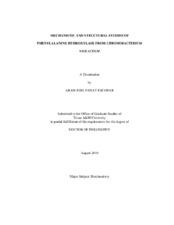| dc.description.abstract | The phenylalanine hydroxylase from Chromobacterium violaceum (CvPheH) is a
non-heme iron monooxygenase that catalyzes the hydroxylation of phenylalanine. This
study presents the use of kinetic isotope effects (KIE) as mechanistic probes to compare
the reactivity of CvPheH and that of the eukaryotic aromatic amino acid hydroxylases.
This study also describes the use of different spectroscopic and kinetic techniques to
identify the hydroxylating intermediate for this enzyme and the assignment of the NMR
backbone resonances of CvPheH.
Kinetic isotope effects on aromatic and benzylic hydroxylation were used to
establish that bacterial and eukaryotic phenylalanine hydroxylases have similar
reactivity. The observed KIE on aromatic hydroxylation of 1.4 was shown to be a
combination of an inverse isotope effect on the hydroxylation of the amino acid and a
normal isotope effect on a subsequent step in the reaction. An isotope effect on benzylic
hydroxylation of 10 was found for CvPheH. This result establishes the similar reactivity
for CvPheH and the eukaryotic aromatic amino acid hydroxylases and suggests the
involvement of a common hydroxylating intermediate.
Kinetic isotope effects were used to study the hydroxylation of the aliphatic
substrate cyclohexylalanine. The Dkcat value with [1,2,2,3,3,4,4,5,5,6,6-2H11]-
cyclohexylalanine is unity with wild-type CvPheH, suggesting that chemistry is not ratelimiting
with this substrate. The intramolecular isotope effect calculated using
[1,2,3,4,5,6-2H6]-cyclohexylalanine yields a value of 14. This result is evidence for the
involvement of a reactive iron species capable of abstracting a hydrogen atom from the
aliphatic carbon in cyclohexylalanine.
Analysis of the CvPheH reaction using freeze-quench Mössbauer spectroscopy
allowed the detection of an Fe(IV) species in the first turnover of the enzyme. Chemical
quench and stopped-flow spectrophotometric methods were used to establish the kinetic
competency of the Fe(IV) intermediate as the hydroxylating species.
The NMR amide backbone resonances in the HSQC spectrum of CvPheH were
assigned to the corresponding amino acid residues using a suite of TROSY-based threedimensional
triple resonance experiments. We were able to assign 224 residues out of
the 278 assignable residues in CvPheH, this constitutes 81 percent of the assignable protein
sequence. | en |


